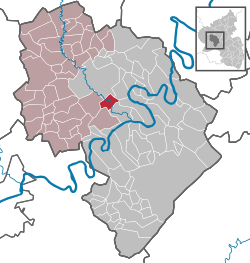Platten, Germany
| Platten | ||
|---|---|---|
| ||
 Platten | ||
Location of Platten within Bernkastel-Wittlich district  | ||
| Coordinates: 49°57′08″N 6°57′17″E / 49.95222°N 6.95472°ECoordinates: 49°57′08″N 6°57′17″E / 49.95222°N 6.95472°E | ||
| Country | Germany | |
| State | Rhineland-Palatinate | |
| District | Bernkastel-Wittlich | |
| Municipal assoc. | Wittlich-Land | |
| Government | ||
| • Mayor | Alfons Kuhnen | |
| Area | ||
| • Total | 6.63 km2 (2.56 sq mi) | |
| Population (2015-12-31)[1] | ||
| • Total | 883 | |
| • Density | 130/km2 (340/sq mi) | |
| Time zone | CET/CEST (UTC+1/+2) | |
| Postal codes | 54518 | |
| Dialling codes | 06535 | |
| Vehicle registration | WIL | |
| Website | www.weinort-platten.de | |
Platten is an Ortsgemeinde – a municipality belonging to a Verbandsgemeinde, a kind of collective municipality – in the Bernkastel-Wittlich district in Rhineland-Palatinate, Germany.
Geography
Location
The municipality lies on the river Lieser in a side valley of the Moselle. The nearest middle centres are Wittlich and Bernkastel-Kues. Platten belongs to the Verbandsgemeinde of Wittlich-Land, whose seat is in Wittlich, although that town is itself not in the Verbandsgemeinde.
History
In 1084, Platten had its first documentary mention as villa Platana. Beginning in 1794, Platten lay under French rule. In 1814 it was assigned to the Kingdom of Prussia at the Congress of Vienna. Since 1947, it has been part of the then newly founded state of Rhineland-Palatinate.
Politics
Municipal council
The council is made up of 12 council members, who were elected by proportional representation at the municipal election held on 7 June 2009, and the honorary mayor as chairman:[2]
| WG Kuhnen | WG Marx | Total | |
| 2009 | 8 | 4 | 12 seats |
Coat of arms
The German blazon reads: Im silbernen Schildhaupt ein rotes Balkenkreuz, darunter in Blau ein silberner Schrägbalken, belegt mit drei goldenbesamten, fünfblättrigen, roten Rosen. In Blau oben ein silberner Forsthaken.
The municipality’s arms might in English heraldic language be described thus: Azure a bend argent charged with three roses gules seeded Or, above which a cramp palewise of the second, in a chief of the second a cross of the third.
The red cross in the chief is the armorial bearing once borne by the Electorate of Trier, which was once the village’s landholder. The bend (slanted stripe) charged with the three roses is the arms borne by the noble family “von Platten”, also known as “Haich von Platten”, whose seat was Castle Neuerburg near Wittlich. This composition is handed down through Paul von Platten’s seal (from 1390) and a colour drawing in Archbishop Balduin’s book of documents, the so-called Balduineum, for Richard von Platten, who in 1326 was enfeoffed with Castle Neuerburg by this Archbishop. The cramp (double-ended hook, called a Forsthaken, or “forest hook”, in the German blazon, but often called a Wolfsangel, or “wolf’s hook”, in blazons for other German coats of arms that bear this charge) came from the arms borne by the noble family Plait (or Platten), whose ancestral seat was in Platten and who, owing to their holdings in Longuich sometimes called themselves “Plait von Longuich”. The family’s male line died out in the late 16th century with Gerhard Plait von Longuich’s death.[3]
References
- ↑ "Gemeinden in Deutschland mit Bevölkerung am 31. Dezember 2015" (PDF). Statistisches Bundesamt (in German). 2016.
- ↑ Kommunalwahl Rheinland-Pfalz 2009, Gemeinderat
- ↑ Description and explanation of Platten’s arms Go to Über Platten>Wappen & Chronik.
External links
- Municipality’s official webpage (German)

